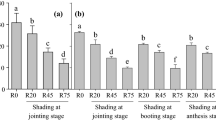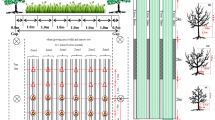Abstract
Measurements of photosynthetically active radiation (PAR), leaf photosynthesis, canopy leaf area index (LAI) and crop yield were carried from flowering to maturity to study the effects of tree shading on crop yield in a Paulownia-wheat intercropping system in China. We found that the tree shading reduced the amount of incoming PAR within the intercropping system by 22%, 44% and 56% during flowering, grain-filling and maturing, respectively. The amount of PAR intercepted by the wheat crop inside the intercropping system was 34%, 55% and 68% less than the crop outside the intercropping system during flowering, grain-filling and maturing. Estimates of PAR-saturated leaf photosynthetic rate were not affected by tree shading, and the differences between the wheat yield inside the intercropping system and outside the intercropping system can be explained by the difference in the amount of PAR intercepted. Total grain numbers and grain dry weight per 1000 grains were linearly correlated with the amount of PAR intercepted during 7 days prior to anthesis and during anthesis and grain-filling, respectively. As compared with the wheat crop outside the intercropping system, grain numbers and grain dry weight were reduced by 36% and 25%, respectively. As a result wheat yield inside the intercropping system was 51% lower than that outside the intercropping system. Our results suggest a much higher reduction in crop yield and much smaller economic gain of the Paulownia-wheat intercropping system than previous studies on the similar Paulownia-wheat intercropping systems in China.








Similar content being viewed by others
References
Bidinger FR, Musgrave RB, Fischer RA (1977) Contribution of stored pre-anthesis assimilate to grain yield in wheat and barley. Nature 270:431–433
Black C, Ong CK (2000) Utilization of light and water in tropical agriculture. Agric Forest Meteorol 104:25–47
Cannell MGR, van Noordwijk M, Ong CK (1996) The central agroforestry hypothesis: the trees must acquire resources that the crop would not otherwise acquire. Agroforestry 34:27–31
Chirko CP, Gold MA, Nguyen PV, Jiang JP (1996) Influence of direction and distance from trees on wheat yield and photosynthetic photon density (Q p) in a Paulownia and wheat intercropping system. Agric Forest Meteorol 83:171–180
Fischer RA (1985) Number of kernels in wheat crops and the influence of solar radiation and temperature. J Agric Sci (Cambridge) 105:447–461
Herzog H (1986) Source and sink during the reproductive period of wheat. Paul Parey Scientific Publishers, Berlin, 104 pp
Liu NZ (1988) Characterics of light distribution within an agro-forestry system and its significance in crop production. Paulownia Agroforest 2:41–45 (in Chinese)
Lu J (2006) Energy balance and economic benefits of two agroforestry systems in northern and southern China. Agric Ecosyst Environ 116:255–262
Lu Q, Yang HX, Ci LJ et al (1997) Transmission of solar radiation in a Paulownia-crop intercropping system and its influences on crop yield and grain quality. Acta Ecologica Sinica 17:36–44 (in Chinese)
Monteith JL (1977) Climate and efficiency of crop production in Britain. Philos Trans Roy Soc B 281:277–294
Montheith JL, Scott RK, Unsworth MU (1994) Resource capture by crops. Nottingham University Press, Loughborough, UK, 469 pp
Muthuri CW, Ong CK, Black CR, Ngumi VM, Mati BM (2005) Tree and crop productivity in Grevillea, Alnus and Paulownia-based agroforestry systems in semi-arid Kenya. For Ecol Manage 212:23–39
Ong CK, Black CR, Wallace JS, Khan AA, Lott JE, Jackson NA, Howard SB, Smith DM (2000) Productivity, microclimate and water use in Grevillea robusta-based agroforestry systems on hillslopes in semi-arid Kenya. Agric Ecosyst Environ 80:121–141
Paut Z, Butow BJ, Blumenthal CS, Wrigley CW (2004) Transport of dry matter into developing wheat kernels and its contribution to grain yield under post-anthesis water deficit and elevated temperature. Field Crop Res 86:185–198
People MB, Beilharz VC, Waters SP, Simpson RJ, Dalling MJ (1980) Nitrogen redistribution during grain growth in wheat (Triticum aestivum L.). Planta 149:241–251
Wang YP, Jarvis PG (1990) Influence of crown structural properties on PAR absorption, photosynthesis and transpiration in sitka spruce: application of a model (MAESTRO). Tree Physiol 7:297–316
Willenbrink J, Bonnett GD, Willenbrink S, Wardlaw IF (1998) Changes of enzyme activities associated with the mobilization of carbohydrate reserves (fructane) from the stem of wheat during kernel filling. New Phytologists 139:471–478
Yin R, He Q (1997) The spatial and temporal effects of paulownia intercropping. Agroforest Syst 37:91–109
Zhu ZH, Cai MT, Wang SJ, Jiang YX (1991) Agroforestry systems in China. Chinese Academy of Forestry, Beijing and IDRC, Canada, 216 pp
Acknowledgement
This study was part of a key project of “research on the optimal design of Paulownia-crop intercropping systems for maximal ecological and economic benefit” funded by the State Forestry Bureau (formerly the ministry of Forestry), People’s Republic of China. We appreciate the valuable advice and assistance from Professor Guoyi Zhou of the Chinese Academy of Sciences and Dr. Yingping Wang of CSIRO, Marine and Atmospheric Research, CSIRO during this study.
Author information
Authors and Affiliations
Corresponding author
Rights and permissions
About this article
Cite this article
Li, F., Meng, P., Fu, D. et al. Light distribution, photosynthetic rate and yield in a Paulownia-wheat intercropping system in China. Agroforest Syst 74, 163–172 (2008). https://doi.org/10.1007/s10457-008-9122-9
Received:
Accepted:
Published:
Issue Date:
DOI: https://doi.org/10.1007/s10457-008-9122-9




